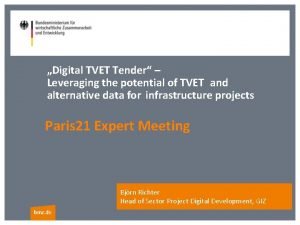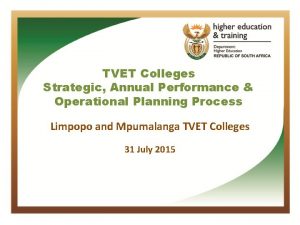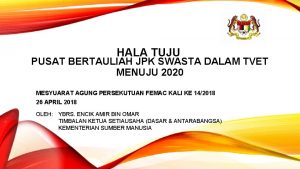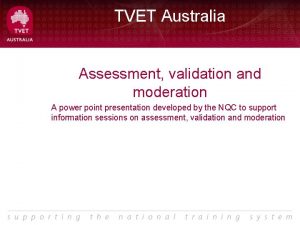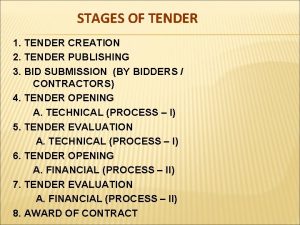Digital TVET Tender Leveraging the potential of TVET






- Slides: 6

„Digital TVET Tender“ – Leveraging the potential of TVET and alternative data for infrastructure projects Paris 21 Expert Meeting Björn Richter Head of Sector Project Digital Development, GIZ bmz. de

Rationale behind Digital TVET Tender Today, Ø Technical and Vocational Education and Training (TVET) often lacks practical relevance Ø Construction companies often rely on foreign personnel to implement infrastructure projects Ø many countries experience shortages of skilled labor while trained workers remain unemployed Reasons are: Ø Industry and TVET systems are inadequately alinged and curriculas not set according to industries need Ø TVET provided often appears to be too theoretical and does not correspond with the requirements and skills needed in the workspace Ø Inadequate data on labour market (availability of labour and skills) bmz. de

The Initiative: Digital TVET Tender The initiative ‚ Digital TVET Tender ‘ aims at leveraging the potential of infrastructure programmes for training national workers on the job The Initiative will: Ø Increase TVET‘s practical relevance by strenghtening practical elements Ø Create incentives for construction companies to provide training Ø Integrate on-the-job training into tenders of construction projects financed e. g. by development banks Ø Leverage digitalization a - digital platform - to identify labor markets needs and training potentials Ø Lower entry barriers for companies quality labour market data enables access to local labour force bmz. de

Data is the Enabler: The Digital TVET Tender Process (on the basis of Mongolias example) 1. Initiation [Build Power Plant of size y] 2. Project Analysis [need for x wokers with z qualification] 3. Labor market data collection [collection of available ressources] 4. Staffing potential / GAP Analysis [15 electrical engineers with qualification level b missing] 5. Qualification Potential [9 electrical engineers with qualification level a can be trained] 6. Return [data, names of potential workers and trainees returned] 7. Monitoring & Evaluation [status and training process can be monitored and reviewed] bmz. de

Data is Key Ø DTT only wokrs with good labour market data Ø Experiences in Mongolia and Pakistan: quality data not available Ø Which alternative data and data sources exist for labour market prediction? bmz. de

Thank you very much! Contact: Bjoern. richter@giz. de bmz. de
